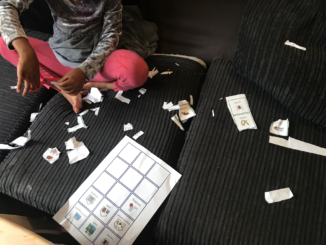The phrase “behavior is communication” was invented in response to a set of ideas, a counter to them.
One of these ideas is that children’s inconvenient or strange or annoying behavior is a sign of some character flaw in the child. That they’re doing it to defy or annoy or enrage the adult. Another idea being that their behavior is pointless and meaningless and unpredictable. Yet a third idea being that it’s impossible to communicate with children when they are unable to speak, or even if they can speak but not as plainly as adults.
None of these things are true, and sometimes people try to communicate that by saying, “Behavior is communication.”
What the phrase “behavior is communication” does NOT mean is that all behavior must be a desperate cry for help for the adult to solve some problem for them.
It is good to be aware that behavior CAN be this kind of communication. It is a million times more likely that a child is communicating “Please help me with something” than “I just want to annoy you for no reason, ha ha ha” or “I’m defiant and a bad human being”. Absolutely. Unequivocally. And that mental framework is far more helpful and more healthy to view children through.
But sometimes I see adults become so desperate to unpuzzle what the behavior must “mean”, as if it always has a secret, grand meaning. But communication doesn’t always mean “communicating big secret grand desperate concepts.”
If you think of verbal communication, just because it’s what the majority of you are probably familiar with, you can easily tell that everything that someone speaks in a day is not ALWAYS asking for help or needing to solve a problem or requesting something or sharing grand mysteries. Sometimes it’s just saying silly little things for the sake of saying them, sometimes it’s jokes, sometimes it’s serious, sometimes you need something, sometimes you want to reach out and talk to someone, sometimes you might even mutter to yourself.
What behavior is communicating might just be, “wonder what this does?” or “I am playing” or “an impulse entered my head so I did it” or “I’m happy!” or “it seemed like it might be fun at the time” or “my brain and body just kinda did that by itself” or “I am four years old and isn’t that a quirky little age” or a zillion other things.
I’m reminded of a time when one of the schools I work at asked me to come do some kind of OT intervention for a kid. Their concern was that he fidgeted with shoelaces.
I asked, his shoelaces or someone else’s? They said his.
I asked, is he untying the shoes and they fall off? They said no, he just fidgets with them.
I asked, why is this a problem that needs intervention? They said, because he is doing some kind of a “sensory behavior”, so we figured he needs OT.
I told them the OT says to let him fidget with his shoelaces if he wants to. It was an example of them over-interpreting what he was communicating. I mean, could he have been communicating that he was bored or that class was at the wrong level of difficulty or whatever? Sure, he could have been. And then the school process is to go through and show through data that he’s falling behind or whatever. Or he might’ve just been “communicating”, “fidget fidget fidget, something to do with my hands” and that’s like…fine. That doesn’t need fixing.
If the behavior is distressing the child, or distressing you, or causing legitimate problems and concerns in the environment they’re in, then I’ve written a lot about ways to troubleshoot those things. I’ll try to link some of them in the comments.
But if you can ask yourself first, is this a problem that needs solving? Exactly the way it is? Or can we just set up around them, exactly the way it is? Is it just for delight or impulsivity or fun? Then maybe there’s no problem to be solved. Maybe the communication is just “hey, see what I can do!”


